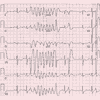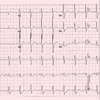ECG Changes in Polymorphic Ventricular Tachycardia
Torsades de pointes, or polymorphic ventricular tachycardia, seen on ECG includes wide complex QRS morphology tachycardia, axis deviation of the QRS complexes around baseline.

Figure 1 –
The initial ECG of a patient with torsades de pointes shows sinus tachycardia, occasional premature ventricular contractions, and nonsustained polymorphic ventricular tachycardia.

Figure 2 –
This ECG, obtained after initial treatment in the emergency department, shows normal sinus rhythm, occasional premature ventricular contractions, and a prolonged QT interval.
A 53-year-old man was brought to the emergency department (ED) after having experienced what his wife described as seizure-like activity at home. He had no previous episodes of seizure and no history of heart disease, coronary artery disease, arrhythmia, stroke, diabetes, or hypertension. He had recently undergone back surgery and was taking cyclobenzaprine and oxycodone/acetaminophen as prescribed.
Examination. On arrival, the patient was awake, alert, and oriented. He had no complaints but did not remember the events of the preceding few hours. Results of his preoperative evaluation the previous month had been normal, including a normal ECG with normal intervals. His triage ECG in the ED (Figure 1) showed intermittent polymorphic ventricular tachycardia (VT).
Hospital course. The patient was taken to an acute-care room in the ED and hooked up to a monitor with defibrillation pads and crash cart at the bedside. Magnesium sulfate and potassium infusions were started empirically to correct for potential electrolyte abnormalities. The patient subsequently became unresponsive, with sustained polymorphic VT. He was defibrillated 3 times (360 joules), with return of pulses and consciousness after the third shock. He had 3 more episodes of sustained polymorphic VT while in the ED and was shocked back to consciousness after each episode. An amiodarone bolus and continuous infusion were started, and after a total of 7 shocks, sinus rhythm was maintained (Figure 2). The patient was admitted to the cardiac ICU for further evaluation. Initial laboratory data showed a normal potassium level and a slightly decreased magnesium level (1.8 mg/dL).
Table 1 – Medications associated
with torsades de pointes
TORSADES DE POINTES: AN OVERVIEW
The term "torsades de pointes" was first used in 1960 to describe polymorphic VT.1 The classic ECG changes associated with this condition include a wide complex QRS morphology (more than 120 milliseconds), tachycardia (more than 100 beats per minute), and the beat-to-beat axis deviation of the QRS complexes around the baseline that is referred to as the "twisting of the points."
Torsades is most commonly associated with prolongation of the QT interval, which may be congenital (as in long QT syndrome) or acquired (as a side effect of medication).1 Medications cause polymorphic VT by directly prolonging the QT interval or by causing electrolyte abnormalities that produce torsades.
The agents most often associated with torsades are listed in Table 1.2,3 Certain medications-such as the antiarrhythmic agents-are best initiated only in a monitored setting because of the frequent incidence of QT prolongation (more than 50 milliseconds) and subsequent VT with these agents.4 Many other medications occasionally increase the QT interval by a shorter length of time (5 to 10 milliseconds) and have rarely been associated with torsades.4,5
A complicating factor in predicting torsades is that there is no direct correlation between the length of the QT interval and the incidence of arrhythmia.1 Other risk factors for torsades are listed in Table 2.1,2 The combined effect of medication and risk factors is unpredictable in any given patient. Therefore, caution is warranted when prescribing medications that are known to prolong the QT interval for patients who have other risk factors for torsades.
TREATMENT
Treatment of polymorphic VT begins in the prehospital setting and continues in the ED according to standard Advanced Cardiac Life Support protocols.6 As with any tachyarrhythmia, the most important determinant of treatment is hemodynamic stability. Immediate electrical cardioversion or defibrillation is required for unstable tachyarrhythmia. Instability is defined as chest pain, hypotension, obtundation, or pulmonary edema. Intravenous sedation for conscious patients is optimal but should not delay treatment.
Unstable polymorphic VT is treated in the same manner as ventricular fibrillation, with immediate unsynchronized defibrillation. However, if the patient remains hemodynamically stable, electrolyte replacement should be the first step.
Table 2 – Risk factors associated with torsades de pointes
The choice of further treatment in the stable patient with torsades depends on the baseline length of the QT interval. If this interval is normal, the torsades is more likely to have been caused by ischemia, reperfusion, or myocarditis and is best treated with -blockers, lidocaine, amiodarone, procainamide, or sotalol.
If the baseline QT interval is prolonged, the arrhythmia is more likely the result of long QT syndrome or a medication side effect. Appropriate treatment in this setting includes magnesium, overdrive pacing, isoproterenol, or phenytoin.4 Because of its safety profile and ready availability, intravenous magnesium has become first-line treatment in all patients with torsades. Even an apparently stable patient may quickly become unstable while undergoing medical management, in which case immediate defibrillation, as recommended in the ACLS protocol, is required.
OUTCOME OF THIS CASE
While in the ICU, the patient remained in sinus rhythm with no further episodes of VT. Results of the echocardiogram and cardiac catheterization were normal. An automatic internal cardiac defibrillator (AICD) was placed for paroxysmal VT. The patient's cyclobenzaprine, which was thought to be the cause of his QT prolongation and subsequent polymorphic VT, was discontinued. Known cardiac side effects of cyclobenzaprine include hypotension, arrhythmias, and heart block; however, there are no well-documented cases of torsades de pointes with this agent.3
At a recent follow-up office visit, the patient was doing well, with no episodes of AICD firing and no runs of VT on device interrogation.
References:
REFERENCES:
1.
Roden DM. Drug-induced prolongation of the QT interval.
N Engl J Med.
2004;350:1013-1022.
2.
Zeltser D, Justo D, Halkin A, et al. Torsade de pointes due to noncardiac drugs: most patients have easily identifiable risk factors.
Medicine.
2003;82:282-290.
3.
Arizona CERT. QT drug lists. The University of Arizona Center for Education and Research on Therapeutics, Arizona Health Science Center, Tucson, Ariz. Available at:
http://www.torsades.org
.
4.
Velebit V, Podrid P, Lown B, et al. Aggravation and provocation of ventricular arrhythmias by antiarrhythmic drugs.
Circulation.
1982;65:886-894.
5.
Keren A, Tzivoni D. Torsades de pointes: prevention and therapy.
Cardiovasc Drugs Ther.
1991;5:509-513.
6.
Cummins RO, ed.
The ACLS Provider Manual.
Dallas: American Heart Association; 2004.